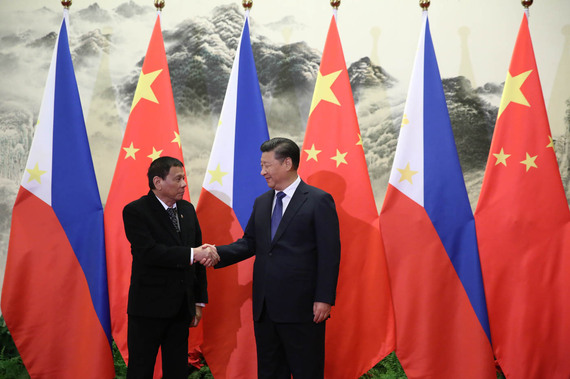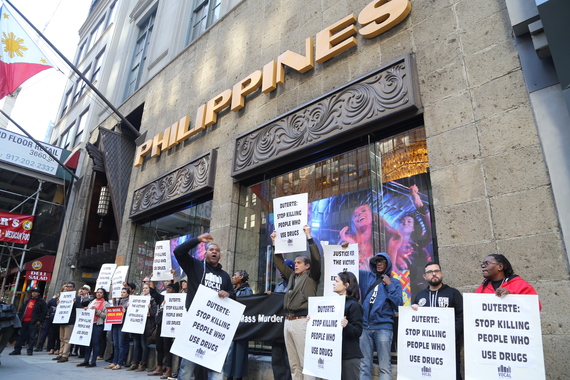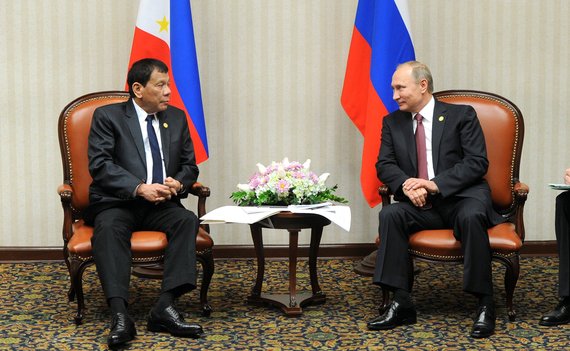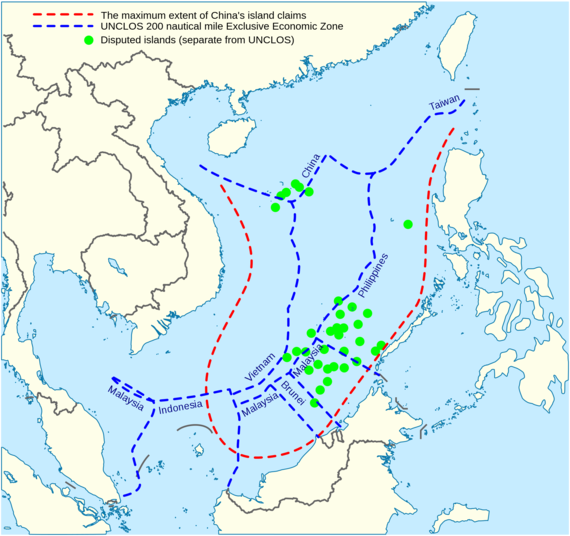Philippine President Duterte with Chinese President Xi, Great Hall of the People, Beijing China October 20, 2016On December 17, 20016 Philippine president Rodrigo Duterte threatened to unilaterally abrogate the Visiting Forces Agreement (VFA) between the United States and the Philippines; announcing that the US should "Prepare to leave the Philippines. Prepare for the eventual repeal or abrogation of the VFA." Signed in 1998, the VFA accorded legal status to thousands of U.S. troops who are rotated into the country for military exercises and humanitarian assistance operations.
In a later speech that day, Duterte also announced that he was reviewing the Enhanced Defense Cooperation Agreement (EDCA) between the US and the Philippines and that he would make a decision shortly on whether he would also abrogate that treatment; adding "Start packing your things and get out of my country," "You want to come back here? You pay us. You want bases here? Pay us." The EDCA covers five military bases which the US currently has in the Philippines.
Since becoming president in June 2016, Duterte has quickly gained a reputation for flamboyant and controversial policies as well as an acerbic and militant style. His militant, anti-American stance, however, is hardly a surprise. Duterte grew up a strident leftwing activist and Philippine nationalist. He has long-standing ties to the Philippine Communist Party and was involved with a variety of groups that agitated for the closure of the Subic and Clark bases in the early 1990s. Duterte's reflexive anti-Americanism brought him to the attention of U.S. consular officials in 2002 and led him to be placed on a list of Philippine citizens ineligible for U.S. visas.
Duterte had announced, upon being elected, that he intended to pursue an "independent foreign policy". On September 12, he declared he was "not a fan of the Americans" and that he wanted to "reorient" foreign policy with the U.S. On September 27, he added that he wanted to pursue "new alliances with Russia and China."
Since, October, however, in response to Obama administration criticisms of the extrajudicial killings of approximately 1,500 suspected drug dealers, Duterte has gone out of his way to distance himself from the United States. He has been sharply critical of the Obama administration. His torrents of expletive laden criticisms of the American president prompting the White House to abruptly cancel a planned meeting between Obama and Duterte during the Hangzhou G20 conference in September. The two men later met informally.
Addressing a group of 200 Philippine and Chinese businessmen at the Great Hall of the People, on October 20, he dramatically announced that, "America had lost" and that "China had won" and the "separation" of the Philippines from the United States.
At the meeting, which was also attended by Chinese Vice Premier Zhang Gaoli, Duterte announced that he had "realigned myself in your ideological flow," and threatened to seek closer ties with Russia and, "tell him [Vladimir Putin] that there are three of us against the world." He also announced that the two countries would engage in bilateral negotiations in their dispute over ownership of the Scarborough Shoal in the South China Sea.
The announcement highlighted a dramatic trip by Duterte to China, during which Beijing pulled out all the stops to welcome the Philippine president with the sort of pomp and ceremony typically reserved for a major power. Per Ramon Lopez, the Philippines's Trade Secretary, some $15 billion, later raised to $24 billion, in trade and investment deals were signed as a result of the visit.
The announcement marked the beginning of a dramatic and public reversal in Manila's historic foreign policy alignment and represented a stunning setback in Washington's efforts to build a regional coalition backstopped by American military power to contain Chinese expansionism in the South and East China Seas.
The next day, Trade Minister Ramon Lopez tried to walk back some of Duterte's comments, emphasizing that the Philippines would maintain their trade and economic ties with the United States and the West.
On October 26, Duterte, while on a trip to Japan, announced that he wanted all U.S. troops out of the Philippines within two years and that he was prepared to "revise or abrogate agreements" to do so.
Once again, a Philippine government official, this time Foreign Secretary Perfecto Yasay, was quick to walk back Duterte's incendiary comments, stating that Duterte did not mean to imply that U.S. troops would be expelled and that American and Philippine "national interests still continue to converge."
Duterte later pushed back his deadline for a U.S. military withdrawal to 2022, and announced that joint American-Philippine military exercises would end after 2017. He also announced an end to joint naval patrols in the South China Sea. Significantly, however, Duterte has made no mention of ending the 65-year-long mutual defense treaty with the U.S.
Demonstrators at the Philippine Consulate in New York City protest against the extrajudicial killings of suspected drug dealers in the Philippines. October 11, 2016
Both China and the U.S. are key trade partners for the Philippines. China was the Philippines' second largest trading partner in 2015, with bilateral trade worth $17.7 billion. The total value of U.S. trade with the Philippines was around $16.5 billion, placing it behind both China and Japan; the latter was the Philippine's largest trade partner with bilateral trade worth $18.7 billion. The U.S. is, however, the Philippines' largest foreign investor.
It's unclear at this point whether Duterte's new political realignment with China represents a bargaining stance with the U.S. or the beginning of a new, tectonic realignment in the international relations of Southeast Asia. What is clear, however, is that, so far, his new policies are deeply unpopular among the Philippine political and economic elite, although his personal popularity remains high.
Beijing has made political and military control of the South and East China Seas a key goal of its regional foreign policy. Chinese militarization of the islands it has been building and expanding in the region has raised alarms among its neighbors, causing historic enemies like Vietnam and the United States and Japan and the Philippines to forge closer military ties and expand military cooperation. In June, the International Court of Arbitration in The Hague ruled that China's seizure of the Philippines' Scarborough Shoal had violated Manila's sovereignty.
Duterte's pivot to China may be an attempt to mitigate the consequences of that ruling, one that Beijing found deeply embarrassing and that it has declared it will ignore, on the Philippines' China trade. Following Duterte's visit, Beijing announced that Philippine fisherman could return to the Scarborough Shoals and that the Philippine Coast Guard would resume patrols there. The agreement, described as an "oral understanding," left untouched the more contentious issue of sovereignty.
Beijing's strategy also underscores the effectiveness of China's hard and soft diplomacy, the willingness to act unilaterally in seizing and fortifying disputed islands and shoals in the region, and using its growing military strength to intimidate its neighbors, while at the same time also proffering its soft diplomacy of investment and access to China's huge internal markets.
Duterte's visit to China was quickly followed by a similar visit by Malaysian Prime Minister Najib Razak. On November 1, Razak announced that the two countries had signed bilateral trade and investment deals worth $34.25 billion dollars. Malaysia also agreed to buy four littoral mission ships from the Chinese. Significantly, Razak also announced that Malaysia would engage in bilateral negotiations with China over disputed areas of the South China Sea.
Razak's relations with the Obama administration have been strained ever since the U.S. Justice Department opened an investigation into the use of American banks to launder as much as a billion dollars that, Washington believes, was looted from a Malaysian State Development fund by his associates and family members.
While the Obama Administration's criticisms of Duterte and Razak are partially responsible for their apparent overtures to China, it also underlines the relative failure of the Obama administration's much vaunted "pivot" to Asia. Although there has been an expansion in bilateral military cooperation with several countries in the region, the centerpiece of that policy, the Trans-Pacific Partnership, the proposed free trade area in the Asia-Pacific region, appears to be stillborn given President-elect Donald Trump's opposition to it.
China's interest in the South China Sea has been driven by a fundamental and far-reaching change in China's economy. Historically, China has been largely self-sufficient. When direct European trade with China began in earnest in the 16th century, European merchants found there was little that they could interest the Chinese in buying. Furs were a highly profitable commodity, but the trade in furs was relatively miniscule when compared with the boatloads of tea, silk and porcelain that China dispatched to Europe.
Phillipine President Duterte with Russian President Putin, APEC Summit, Lima Peru, November 19, 2016
For much of the 16th through the early 19th centuries, a river of silver flowed from Europe and the Americas to China where it was exchanged for Chinese goods. It wasn't until British merchants in India discovered that opium produced in the Indian highlands could be very profitably sold in vast quantities in China that the lopsided balance of trade with China began to reverse. In the process, they created the first international drug cartel; one that also benefitted by being defended by the Royal Navy, then the world's most powerful.
Today, however, the Chinese economy is heavily dependent on its external trade, both for markets for its manufactured goods and for essential raw materials. Far from being self-sufficient, Chinese industry today imports vast quantities of raw materials and foodstuffs. It is the world's largest user of such critical materials, among others, as iron, copper, lead and zinc.
The vast majority of China's commodity imports travel by sea, as do virtually all its exports. Sea power, which historically has not figured prominently in Chinese history, is thus assuming a far more significant role in China's strategic thinking.
As China's economy has grown and has, in turn, become ever more dependent on the export of its production and the import of the critical raw materials and foodstuffs needed to run it, China's perceived need to secure and control its maritime approaches has become stronger.
Currently China's defensive doctrine identifies two key geostrategic boundaries: the "first-island-chain" and the "second-island-chain." The first-island-chain encompasses a vast area centered around the South and East China Sea. It begins off the coast of Indochina, curves around Borneo and the western coast of the Philippines, and extends north along the eastern coast of Taiwan, all the way to the southern coast of Japan.
From a naval standpoint, Chinese strategists see this region as "China's backyard." Moreover, it is characterized by a series of "choke points" where hostile naval forces could interdict or blockade Chinese shipping and cripple China's economy. Some $6.5 trillion in goods pass though this region yearly.
Beijing claims that its assertion of a strategic interest in the geographic zone comprised of the "first-island-chain" is no different than America's declaration of the Monroe Doctrine in 1823. Regardless of the rationale, China's aims, to be successful, would require every one of its neighbors along the South and East China Seas to significantly compromise their claims in the region. It would also force a de facto withdrawal by the U.S. Navy from the East Asian littoral. It's unlikely that the U.S.'s bilateral defense treaties with those countries would survive such a pullback.
Even more problematic is Beijing's delineation of the "second-island-chain." This zone encompasses the Philippines and Japan and extends eastward to Palau, Guam and the Northern Mariana Islands. Significantly in 2015, the PLA Air Force began flights by Chinese H-6K long-range bombers over the Western Pacific, extending to a point about 600 miles west of Guam.
Competing territorial claims in the South China Sea
China's ambitions to dominate the sea-air space as far as the "second-island-chain" may be either wishful thinking or little more than posturing. On the other hand, China's ambitious naval construction program suggests that the strategy is more than empty rhetoric. For the U.S. to be effectively excluded from this second zone would represent a collapse of American naval power in the Western Pacific not seen since the aftermath of the Japanese attack on Pearl Harbor.
Chinese strategists have also, of late, been raising the prospect of a "third-island chain"-one that extends as far west as the Hawaiian Islands, and would include the Aleutians as well as Micronesia, and extend all the way to New Zealand.
Ironically, the strategic origin of the "island-chain" concept was American. In 1951, John Foster Dulles suggested the construction of three successive island chains as a containment strategy to surround the Soviet Union and the People's Republic of China. Washington never adopted the strategy, but Beijing has incorporated it into its own strategic thinking, both as a critical element of China's own defense and as a strategy for containing American naval power in the Pacific.
This is not an outcome that Washington will accept. Even the "first-island-chain" would represent nothing less than a complete reorientation of the strategic balance of power is East Asia. What is clear is that the tension in the South China Sea is unlikely to dissipate any time soon and that the consequences of China's ambition's in the area will reverberate politically, economically and diplomatically, well into the future.
Duterte's dramatic announcement may be nothing more than empty rhetoric on the part of a controversial and flamboyant Philippine leader. Likewise, Razak's coziness with Beijing is more likely to be a tactical ploy than a strategic realignment. Claims that the "dominoes" in Southeast Asia have started to fall into China's lap are premature and not yet supported by the facts. Then again, with the benefit of hindsight, these developments could turn out to be the first steps in Beijing's ambition to restore China's historic hegemonic role in Southeast Asia.
An earlier version of this article apppeared in Military.com. Reprinted here by permission.




